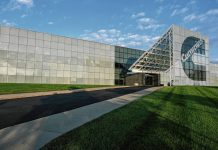A church building in Columbus known internationally as an iconic architectural treasure has been named one of the top 10 most endangered landmarks in Indiana.
North Christian Church, 850 Tipton Lane, one of seven National Historic Landmarks in the city, is not on the list for the usual reasons that structures are chosen, said Mark Dollase, Indiana Landmarks vice president of preservation services.
Normally, the top 10 list includes structures that have a combination of problems rather than a single threat — abandonment, neglect, dilapidation, obsolete use, an unreasonable asking price, a remote location or owners who lack money for repairs, Indiana Landmarks officials said.
Having North Christian on this list is unusual because it’s not a building that is dilapidated or believed to be in dire condition, Dollase said.
[sc:text-divider text-divider-title=”Story continues below gallery” ]
“It’s about trying to work with a congregation that is struggling as a steward of the building,” he said.
As Indiana Landmarks noted in its announcement, “Even internationally known landmarks designed by famous architects (in this case Modernist architect Eero Saarinen) can get in trouble.”
Dollase said the church’s dwindling congregation — with about 35 members in a church designed to hold hundreds of worshippers — is not in the position to afford the types of repairs the aging building needs now. Those include replacing the building’s heating, ventiliation and air condition system, among other repairs and maintenance that need to be done.
The church, completed in 1964, is best known for its 192-foot, needle-like spire reaching toward the sky. In the building’s heyday, when influential community members such as the late J. Irwin and Xenia Miller were members, it had more than 300 people attending services most Sundays.
The Saarinen building, along with the Bartholomew County Courthouse, are two of the most recognized buildings people think of when Columbus comes to mind, said local architect Louis Joyner, who is chairman of Indiana Landmarks Indiana Modern affinity group.
The congregation has sought a national Sacred Places Grant, which provides up to $250,000 in grant money, which needs to be matched by the local community with $250,000 in donations, Dollase said.
“The problem you have is you have to match those grants,” Dollase said.
Indiana Landmarks also has a Sacred Places Indiana grant program and North Christian was in the first cohort of applicants three years ago, Dollase said. That grant was used to try to come up with ideas for additional uses for the building. But because of a number a internal issues, the congregation was unable to come up with a plan as the membership continued to dwindle, he said.
National Historic Landmark status is an honor, but it brings no money to help support the site, according to Indiana Landmarks. The church hopes space sharing may be a saving solution in the future.
Dollase said he is hopeful that some national foundations and trusts might see North Christian Church on the Indiana Landmarks list and take an interest in an endangered Modernist building with such an important pedigree.
Saarinen (1910-1961) viewed most post-World War II churches as ordinary structures that lacked the grandeur and prominence achieved by cathedrals of earlier times, Indiana Landmarks officials said.
“He aimed higher, seeking to inspire worshippers inside as well as viewers from afar with his revolutionary design, with a hexagonal sanctuary on a raised berm topped by the sky-piercing 192-foot spire,” the Indiana Landmarks news release said of Saarinen, who died three years before construction was completed in 1964.
“It’s an amazing building,” Joyner said of the church. “You can learn so much about Saarinen — what he was thinking in terms of the design. He was always innovating … this is really innovation in a church … an expression of faith. The whole building grows out of that idea.”
In addition to the craft, design and construction of the church being top-notch, Joyner said Columbus residents shouldn’t forget that the church is surrounded by a landscape design by Dan Kiley (1912-2004), who is nearly as famous in landscape design as Saarinen is in architecture.
Kiley placed four parking courts amid meadows and woods, with magnolias, dogwoods and flowering plants filling the 13.5-acre grounds.
“It’s one of Dan Kiley’s most important landscapes,” Joyner said.
The ultimate goal of placing North Christian on the top 10 endangered list is to find support and solutions to upgrade the building, so that the congregation can complete renovations and work to preserve the building into the future.
“We would love it if it would disappear off the list next year,” Dollase said.
[sc:pullout-title pullout-title=”The Top 10 endangered bulidings” ][sc:pullout-text-begin]
The 10 Most Endangered in 2018 includes one site repeating from last year’s list and nine new entries:
- Cannelton Historic District, Cannelton
- Commandant’s Row at Indiana Veterans’ Home, West Lafayette
- The Courtyard Inn, Rising Sun
- Cravenhurst Barn, Madison
- Marion National Bank Building, Marion (repeat entry from 2017 list)
- Muncie Fieldhouse, Muncie
- North Christian Church, Columbus
- Old Masonic Hall, Knightstown
- Rocky Edge, Terre Haute
- Saint Joseph’s College campus, Rensselaer
[sc:pullout-text-end][sc:pullout-title pullout-title=”To learn more” ][sc:pullout-text-begin]
To find out more about each of the 10 Most Endangered buildings, and check out some success stories, visit indianalandmarks.org or contact Indiana Landmarks, 317-639-4534 or 800-450-4534.
[sc:pullout-text-end]




